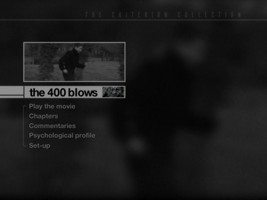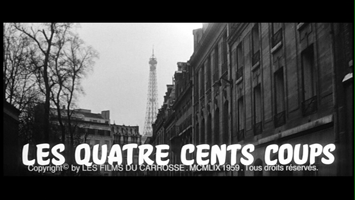directed by François Truffaut
story by François Truffaut
adapted by François Truffaut and Marcel Moussy
dialogue by Marcel Moussy


i.e. The 400 Blows.
Quite wonderful and definitely my favorite Criterion Collection pick so far. This being number five and all previous disclaimers regarding the longevity of this project continuing to apply. Coming up very soon on their list are various roadblocks – a whole slew of discs that are out of print and thus extremely hard to come by in the Criterion edition (there are always illegal ways, online, but do I really want to go there? not particularly), and, more distressing still, movies that I really REALLY don’t want to subject myself to. So I’ll either be dropping the whole thing cold or coming up with convoluted policies to rationalize the ones I skip.
“Quite wonderful and definitely my favorite Criterion Collection pick so far,” I said. As the guy says in that book about books you haven’t read*: we have all kinds of impressions of works we haven’t actually experienced, because just knowing they exist means sorting them and fitting them into our picture of the wider culture. In my picture of the wider culture, I have a chunk of property carved out for “European art movies” where I can toss all sorts of titles I haven’t yet seen. Having given them a category and seen a couple, I assign some basic prejudices to them. I articulated some of those prejudices here: “slower pace, less artifice, more interest in the human, more room for the lyrical and the profound, more ambiguity, greater resonance.” But the more basic prejudice is the one that can’t be articulated, that being my overall sense of what that all adds up to: what a European art movie “is like” and, more pointedly, what it “is worth to me.”
Because while I can nod at each of the attributes in that list I just copied from my entry of two years ago: yes, yes, they are all true of The 400 Blows – I also feel that what they signify as a whole is not true of The 400 Blows. Having thrown its title on the “arthouse” pile in my brain, I felt while watching that though I had categorized it correctly by all objective standards, I had gotten it wrong subjectively.
I’m not about to come out here and say that I have never been touched or moved or impressed by an arthouse movie – but this one moved me at a more basic level. It actually reminded me of life, and elicited emotions directly. Most of the time, arthouse movies seem to me to be specifically and intentionally rejecting the rhythms of commercial filmmaking. I think of them as having a rubato drift – all inflection, no drive – which is, in its way, just as artificial and arbitrary a tendency as anything out of Hollywood. But this was nothing like that: it actually worked. Somewhere in the bonus features Truffaut is seen saying that he thinks rhythm is the most important and most difficult aspect of filmmaking. Amen. His attention to it shows and means a lot. He says that his New Wave intentions were not to invent a new style of film but simply to correct mistakes he found in other films, to make films more true to life, and I believe him.
It’s also possible that I’ve just grown up a bit; I notice that I am more comfortable playing music at slower tempi, recently, which seems temperamentally relevant.
I’m going to be a bit bolder, from now on, about calling out rhythms that aren’t working. During slow famous movies I always tell myself that the deliberate pace is a kind of poetry and that I need to try to savor and enjoy it. But just now, watching the first few minutes of the next Criterion Collection movie – look it up if you want to know – there was a shot where some people were leaving the scene, and we stayed with the shot until they had all left. Only then did it cut away. After a point, the “meaning” of the shot had lapsed and it became only a mechanical matter of waiting for them to finish their motion. In that sense of waiting I recognized the feeling that I am constantly suppressing during art movies: “this moment means nothing and I don’t need it to process what came before, so I have nothing to think about; speed it up.” I am not an unthoughtful person! If a movie gives me absolutely nothing to think about for two seconds during a movie, dammit, I’m going to be honest and say: those are two mishandled seconds. Art movies get away with mishandled seconds at the beginnings and ends of shots all the time.
Not so here. He is in tune with the pulse of every scene, and, inconspicuously, of the whole movie. The ending is, I am not alone in saying, the most beautiful thing about The 400 Blows. It harnesses a carefully controlled accumulation of pressure that you the viewer have not even noticed until it is released. Commentary in the booklet seemed to be saying that the ending is positive, a hope and a relief, but I didn’t feel it that way at all. We spend the whole movie building a sense of pain that this child is not loved, and when the catharsis finally comes he is still entirely alone and unloved; only the rhythms have changed. The great sadness of that can only be accomplished through craft, and it was pulled off perfectly. I found myself shocked into crying, which is very high and rare praise from my skull, especially seeing as I was neither alone nor sleepy, when I tend to be more susceptible to tear-jerking.
The fantastic score is a major contributor to the impact of the movie. One of the most effective I’ve heard in a long time. During the movie I assumed it was by the ubiquitous Georges Delerue, but no – it’s by a guy named Jean Constantin who hardly did anything else in film. Which seems a shame, because this is really effective stuff. Here’s the Main Title, which is essentially identical to the Finale. I think it was the pizzicato solo violin that got me to tear up – a really brilliant, perfect choice.
Having seen this, it now becomes much clearer to me that Wes Anderson and his ilk are doing candied impressions of this material and style. Even the score was more or less copped for Rushmore. But this was relentlessly sincere, whereas Wes Anderson’s personal demons are not at issue in his movies in any obvious way – more like he’s made (Truffaut’s?) personal demons into fetish objects and papered his walls with those.
This made an interesting follow-up to Amarcord, since they both seemed to serve a similar memory-function for their respective filmmakers, but approached from two diametrically opposed perspectives. Beth asked me which was better. Apples and oranges, clearly. But I am personally much more of an apple than an orange, and I had a deeper experience with this one. Truffaut, in a sense, was the braver artist in that he truly reentered his emotional past, whereas Fellini seemed to want a solution that would allow him to use his past without having to inhabit it. Watching The 400 Blows was like hearing a plea directly from that boy in the film. The 27-year-old Truffaut, seen in a television interview, seems truly to be the character we’ve just seen, aged only a few more years. When the filmmaker puts himself into a carnival spinner with the protagonist and whirls them around at the speed of film, the implication seems pretty clear.
The performance by Jean-Pierre Léaud must be the best acting by a child ever committed to film, yes? Even more remarkable when you learn that all the audio was recorded later. The best feature on the disc is the audition footage of Léaud, instantly revealing himself to be perfect.
Oh yeah, the disc. Two commentaries: one from the original laserdisc, by a scholar type, Brian Stonehill. He’s well-organized and overall fairly reasonable, but the analysis isn’t particularly thoughtful or convincing. Actors reading from Truffaut’s letters and transcripts of various interviews are slipped into the mix; the whole thing feels planned and scripted enough that it ought to be better. The second commentary is a more recent interview with Truffaut’s lifelong friend Robert Lachenay, who corresponds to the friend character seen in the movie. There is overlap with the first commentary, but the personal touch is meaningful, if a bit depressing: Lachenay sighs distractedly throughout and is clearly trying not to dwell on the fact that his friend is dead, at least not while the tape is running.
* Which, ha ha, I haven’t exactly read.